Simple staffing plan template! Imagine your business is like a building. A simple staffing plan is your blueprint for making sure you have all the right people to build it strong and tall! It helps you figure out who you need to hire, when to hire them, and how to make your team the best it can be.
Essential Components of a Staffing Plan
Let’s dive into the essential components of a staffing plan:
Current Workforce Analysis
- The Who’s Who: This is all about understanding your existing team. List out the following:
- Job Roles: Every position in your company, from the CEO to the summer intern.
- Skills Inventory: What is each person amazing at? This goes beyond job titles (think: coding, customer service, creative problem-solving).
- Headcount: Simply, how many people do you employ right now?
- Why It Matters: This gives you a solid foundation. You can’t know where to go next until you know where you’re starting from!
Future Staffing Needs
- Crystal Ball Time (Sort Of): Forecasting means looking ahead. Consider:
- Growth: Do you want to expand your business, offer new products, or open new locations?
- Expansion If you’re growing, you’ll probably need more people. What kinds of skills will they need?
- Attrition: This is a fancy word for people leaving – retiring, moving on to other jobs, etc. It happens! Your plan needs to account for replacing those employees.
- Why It Matters: Proactive planning is cheaper and smarter. If you know what’s coming down the road, you won’t be scrambling to hire at the last minute.
Skill Gap Identification
- Spotting the Mismatches: This is where you compare your current workforce (#1) with your future needs (#2). Where do things not line up? Maybe you need:
- People with entirely new skills that no one in your company currently has.
- More people with specific skills you already have, but not enough of.
- Why It Matters: Knowing your gaps lets you make super focused hiring decisions. Instead of just hiring anyone, you’ll know exactly what type of person to look for.
Recruitment Strategies
- Filling those Gaps: How you actually find those great new employees matters!
- Internal Promotions Could someone already in your company step into a new role? This can be great for morale and save money!
- External Hiring This means posting jobs, interviewing new people, etc. But where will you look?
- Job boards
- Recruiters
- Industry events
- College programs
- Why It Matters: The right strategy gets the best people. A bakery needs a different approach than a software company!
Budget Considerations
- Money Matters: Hiring isn’t free! Your budget needs to include:
- Hiring Costs: Advertising jobs, recruiter fees, etc.
- Training Expenses Getting new hires up to speed often involves some training time or resources.
- Salary Projections: Obviously, you need to know what you can afford to pay!
- Why It Matters: Hiring without a budget is a recipe for disaster. A good plan prevents overspending and financial surprises.
Timeline
- Goals with Deadlines: When do you need these new people in place? Depending on your business, this could be:
- Tied to specific project start dates
- Seasonal (hiring extra holiday help)
- A general growth target (needing 5 new people by the end of the year)
- Why It Matters: Timelines keep you focused and prevent last-minute panic hiring, which often leads to bad decisions.
Types of Staffing Plans
Not all staffing plans are the same! Here are a few common types:
Short-term: Think Fast!
These plans are for when you need someone right away. Maybe someone’s going on vacation, or your holiday rush needs extra helpers. Short-term hires might be temporary workers or contractors.
Long-term: Playing the Long Game.
These plans are about the big picture. Where do you want your business to be in a year? Five years? Long-term plans help you hire people who’ll grow with you and reach those future goals.
Project-based: Mission Focused.
These plans are for one-time things. Need a new app designed? A new store opened? Project-based plans get the right people together for that specific job, then they can move on to other things.
Contingency: Always Have a Backup!
Stuff happens – good and bad. A contingency plan is like an insurance policy. What if your star salesperson quits? A great plan has ideas for filling that gap fast so your business doesn’t suffer.
How Do You Create a Staffing Plan?
Ready to make your own plan? Here’s a simple step-by-step guide:
1. Analyze Where You Are:
Employee Inventory: Start by making a list of every person who works for you. Include:
- Their name
- Their job title
- Their key skills and strengths (What are they really good at?)
Spot Missing Pieces: Look at your list carefully. Are there important skills or areas of knowledge that you don’t currently have enough of? This could be anything from website coding to customer service expertise.
2. Look to the Future:
Goal Setting: What do you want your business to achieve in the next few months? What about in the next year or even five years? Be specific!
People Power: Think carefully about your goals. Will you need to do any of the following to reach them?
- Offer new products or services
- Hire more people to meet increased demand
- Find people with specialized skills you don’t already have
3. Find the Gaps:
Comparing Needs vs. Reality: Take a look at the skills you need (from step 2) and your current team’s skills (from step 1). Where are the mismatches?
Types of Gaps: You might realize you need:
- More hands on deck: Simply more employees with the same skills you already have
- New talents: People with skills that no one in your company currently possesses
- A mix of both: Maybe you need to grow your team and find people with new abilities
4. Get Creative with Hiring:
No One-Size-Fits-All: There are tons of ways to find great new employees. Think about:
- Job Boards: Online sites where you post your open positions
- Recruiters: Companies that specialize in finding the right people for you (this can cost more)
- Internal Promotions: Are there people already in your company ready to move up?
5. Budget Wisely:
Beyond Just Salary: Hiring costs more than you might think! Make sure you budget for:
- The cost of advertising your open positions
- Any fees you pay to recruiters
- Training your new hires to get them up to speed
6. Build Your Template:
- Keep it Simple: You can get fancy with software, but to start, a spreadsheet or table works fine. Check out the template example earlier in this article!
Remember: Keep it Simple, Keep it Updated! The best staffing plans are easy to change as your business does.
Smart Staffing Plan Tips
Here’s a closer look at those smart staffing plan tips and how to make them work for you:
Tip 1: Keep It update
Businesses Evolve, So Should Your Plan: Your staffing plan isn’t meant to be written in stone. Think of it as a living document. Here’s when to update:
- Major Changes: Did you land a huge new contract? Merge with another company? Those things will definitely change your hiring needs.
- Regular Check-Ins: Even with no big changes, review your plan at least twice a year. Small updates are easier than a total overhaul!
Why It Matters: Outdated plans are useless. Updating frequently ensures your hiring aligns with your company’s current reality.
Tip 2: Teamwork
Managers as Your Secret Weapon: Your department heads and team leaders know the day-to-day work better than anyone. They can tell you:
- Skills that are in short supply on their teams
- When new projects will make them need more people
- If any employees are looking to grow within the company (potential for promotions!)
Why It Matters: Including managers gives you realistic information. Plus, it helps them feel invested in the success of the plan!
Tip 3: Be Flexible
Expect the Unexpected: Business (and life!) throws curveballs. Things that could require plan changes include:
- Sudden employee departures
- Economic shifts that change your budget
- New opportunities that demand quick hiring
Why It Matters: Rigid plans break. If you build a little flexibility in from the start, those surprises are less stressful. Think of it as planning for what could go wrong, so you’re ready if it does.
Bonus Tip: Communication is Key!
Once you have a plan, don’t keep it a secret. Share relevant parts with your managers and team. This gets everyone on the same page and can spark helpful conversations.
Benefits of using staffing plan template
Here’s a benefits you’ll gain by using a staffing plan template:
Saves Time and Effort
- A Roadmap Instead of Reinvention: Templates provide a framework, so you’re not starting from scratch every time you need to think about hiring.
- Focus on What Matters: With the basics laid out, you spend more time thinking about the skills you need, and less time worrying about how to format a document.
Streamlines the Hiring Process
- Know Who You Need: When you’ve clearly defined your gaps, it’s easier to write job descriptions and target your recruiting efforts.
- Hiring With Goals: A template ties your hiring to your big-picture business goals, helping you find people who contribute to the company’s success, not just fill a chair.
Improves Budgeting and Cost Control
- No Financial Surprises: Budgeting is built into most templates. This forces you to think about the true cost of hiring before you get started.
- Avoiding Overspending: A budget helps you stay disciplined. It lets you make smart decisions about when to use recruiters vs. job boards, for example.
Promotes Strategic Thinking
- Beyond Just Filling a Seat: A good staffing plan makes you think about your business as a whole – where it’s going and how your people get you there.
- Talent as an Investment: Seeing your hiring needs tied to your plans helps you view employees as investments in your future, not just expenses.
Reduces Stress and Improves Decision-Making
- Panic Hiring is Bad Hiring: When you need someone YESTERDAY, it’s easy to make a rushed choice you later regret. A plan removes that pressure.
- Data-Driven Decisions: A thorough template gives you concrete information to base decisions on, making your choices more defensible if needed.
Whether you’re a small business owner or an HR manager in a big company, a template can be adapted to fit your needs. The core principles are the same!
What is a Staffing Plan Template?
Think of a staffing plan template like a pattern for building your perfect team. It gives you a head start with the basic things every staffing plan needs so you don’t have to start from total scratch!
Finding Free Staffing Plan Templates
Before we dive into specific types, here are some great places to find free templates to get you started:
- HR Websites: Many websites focused on Human Resources (HR) offer free template downloads with helpful tips built right in.
- Search Engines: Don’t underestimate a simple search! Try “[Industry] staffing plan template” and see what turns up.
Simple Staffing Plan Templates
Let’s look at why different businesses might need specific staffing plan templates:
Call Center Staffing Plan Template:
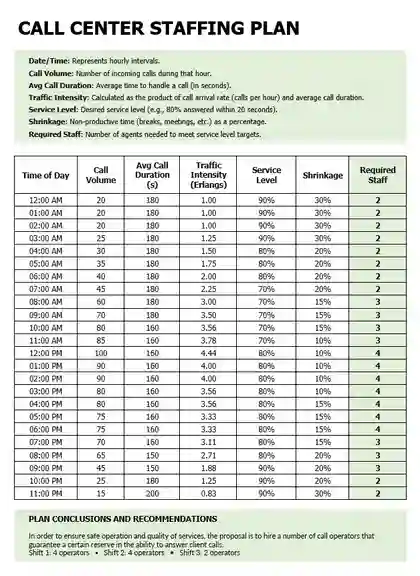
- Focus on Shifts: Call centers often run all day and night, so they need plans for when people should work.
- Predicting Calls: Staffing changes based on how many calls the center expects to get.
Event Staffing Plan Template:
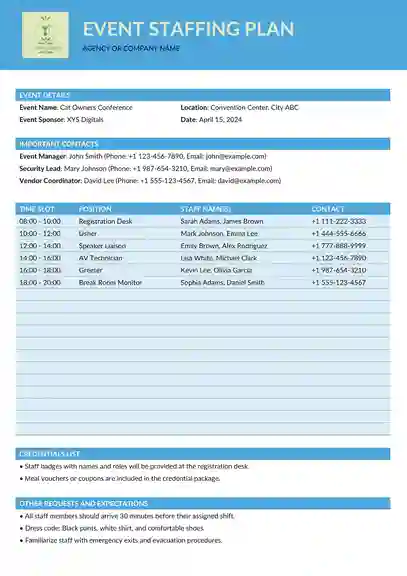
- Short-Term Needs: Events need lots of people, but just for a little while.
- Lots of Jobs: Think beyond just ticket-takers! Events need food service, security, stage crews, and more.
Hospital Staffing Plan Template:
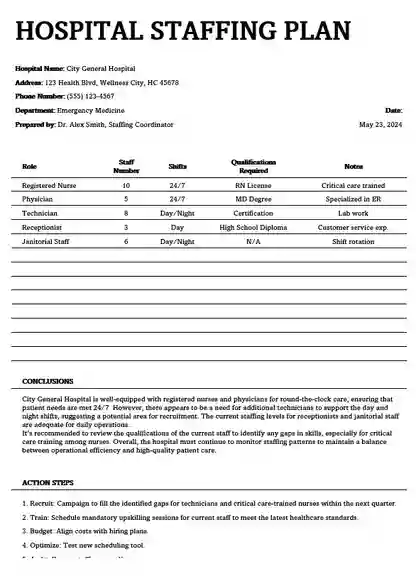
- Many Different Skills: Hospitals need more than just doctors. They need nurses, technicians, office staff… the list goes on!
- Following the Rules: Hospitals often need to meet strict rules about how many patients each staff member can care for.
IT Project Staffing Plan Template:
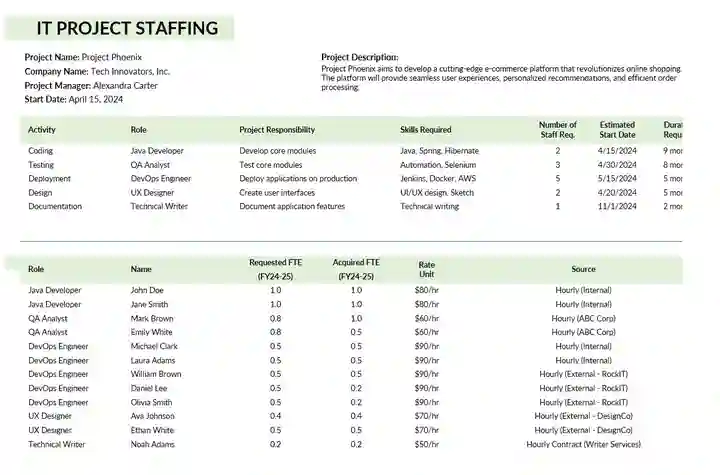
- Tech Experts: These plans focus on finding people who know specific coding languages or software.
- Tied to Deadlines: Projects have end dates, so staffing needs to shift to make sure things finish on time.
Project Staffing Plan Template (General):

- Any Kind of Project: Use these for anything needing people – launching a product, making a website, etc.
- Change it to Fit: These templates work for projects of any size!
Proposal Staffing Plan Template:
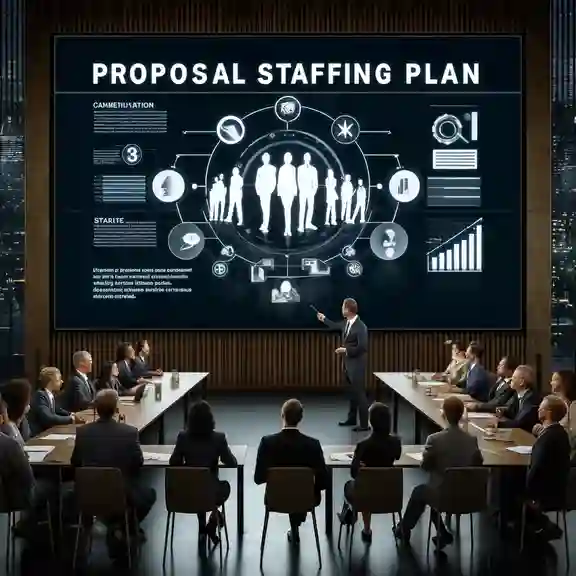
- Winning Clients: These show potential clients you have the right team to do the job.
- Show Off Your Skills: These templates highlight your team’s experience and qualifications.
Restaurant Staffing Plan Template:
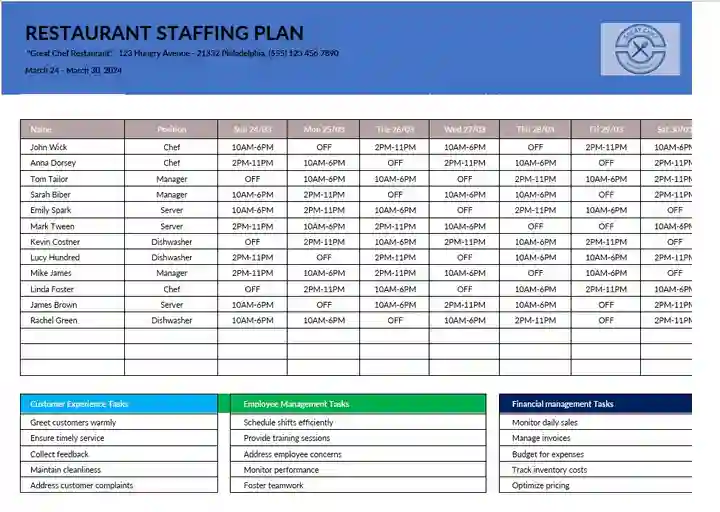
- Tricky Scheduling: Restaurants need to balance waiters, cooks, and more, with big changes based on how busy they are.
- Finding New Hires: Restaurants sometimes lose employees quickly, so their plans might focus on hiring too.
Strategic Staffing Plan Template
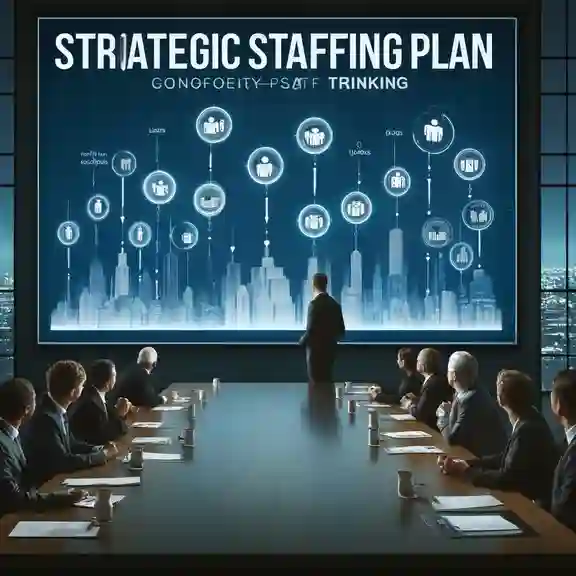
- Big Picture Thinking: These are more about your company’s long-term goals and how your people help you reach them.
- Training Matters: These plans might include ways to help your current employees learn new skills.
Nursing Staffing Plan Template:
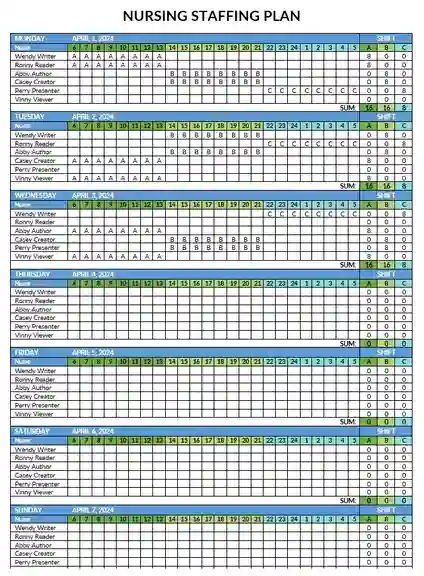
- Like a Hospital, but Just for Nurses: They focus on all the different kinds of nurses (RN, LPN, CNA) a hospital needs.
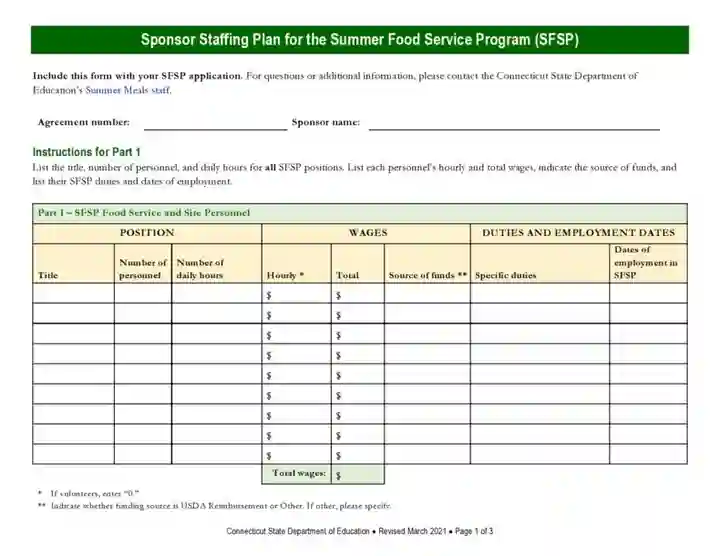
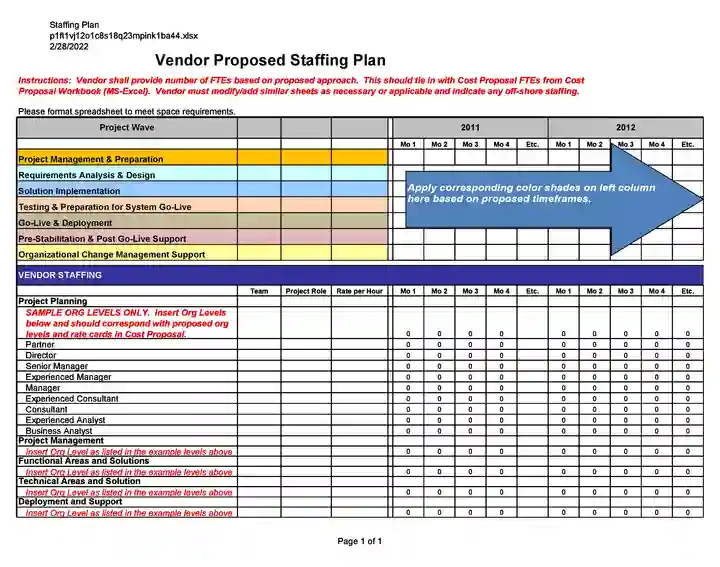
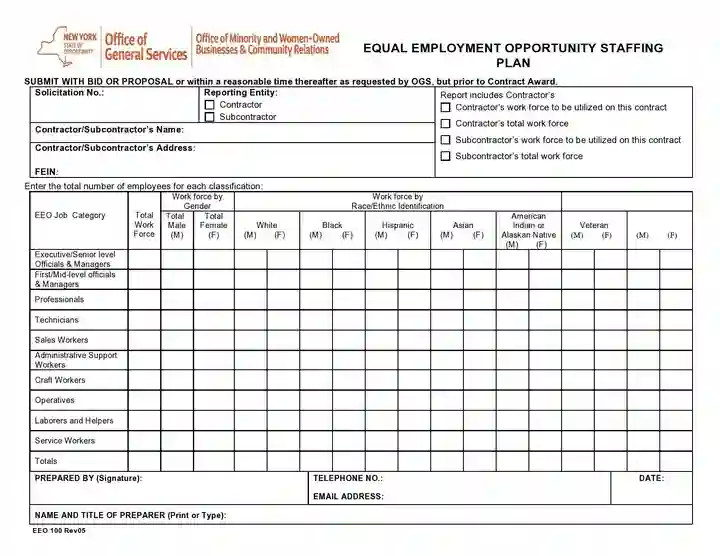
Important! Even great templates might need changes to be perfect for you. Don’t be afraid to customize!
Important Note: No template is one-size-fits-all. The best way to use them is to change them to match what YOUR business needs.
The Big Win
A simple staffing plan template helps you save time, money, and headaches. It makes hiring less stressful and helps you find employees who will make your business shine. Simple plans are a great place to start, so get out there and start building your winning team!

The content creator team at calipsotree.com is dedicated to making topics accessible to everyone, with over 9 years of experience in writing and breaking down complex concepts into easy-to-understand articles that answer readers’ financial questions.








